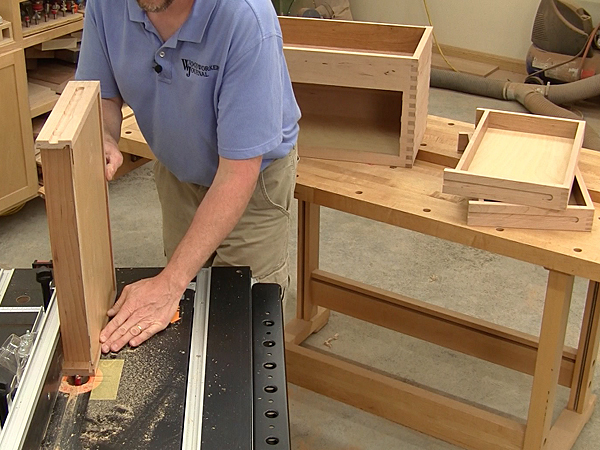
As a reader of the Woodworker’s Journal eZine, I watched Chris Marshall’s Tricks of the Trade video this summer on “How to Cut Stopped Grooves or Dadoes Using a Router Table.” In the video, Chris makes a drop cut, lowering his workpiece onto a spinning router bit. I was wondering why it was done this way and not starting from the open end of the intended cut? It would seem to this long-time DIYer that it may prove tricky to lower the piece down “exactly” where you want the cut to start even with the reference lines. – Laurie Taite
Chris Marshall: Here’s why I did a drop cut in this instance. If I had started both of those stopped cuts from the back “open” end of the drawer shown in the video, I’d have to flip the drawer around for making the second cut on the other side of the drawer. In doing so, I’d be presenting the top edge of the drawer to the router fence for one cut, then the bottom edge of the drawer to the fence for the other cut.
That would be fine, provided the router fence is EXACTLY centered on the bit, because flipping and routing would yield centered slots. But, Murphy’s Law often punishes us otherwise. If the fence weren’t perfectly centered (which, more often than not, it isn’t — it’s always a tiny bit off-center), starting from the open end would create two slots that won’t line up perfectly with one another across the drawer. They’ll be offset from one another the distance that the fence isn’t centered on the bit. And offset slots will make installing the slides more complicated or result in a drawer that won’t hang straight in its opening.
Here’s another example where drop cuts are good to know how to do: sometimes, you have to both start and stop a cut “blind” instead of being able to start in from the open end: think of a typical mortise or drawer bottom groove, where cutting the groove all the way across the workpiece will cause it to show at the corners when you put the drawer together.
If you mark the edges of the bit accurately on either your router fence or right on the router table, it’s not hard to start or stop a cut precisely on the mark. I’ll often “sneak” up on it by setting the workpiece down on the bit just a tad shy of my mark, then sliding the workpiece carefully up to my starting point. You don’t have to hit the “start” point immediately in the cut; just getting there in the end is what matters.
Tim Inman: I love being known as an “artisan” in the trade. Woodworkers and furniture makers are a delicious combination of skill and art. Most of what we do is driven by the artistic expression of our projects. Some of it is driven by utility and usefulness and some is controlled by the equipment we use to execute our goals. We are skilled, but we are also artists. Knowing HOW to do something like a drop cut is important. It is not important to always do a drop cut if there is another simpler, better way to do the job. But, sometimes there isn’t another better, simpler, safer way. Knowing HOW to do it gives us total freedom to enjoy the expression of our art – and get the job done safely and efficiently. Especially for those of us who make a living doing things like this!





